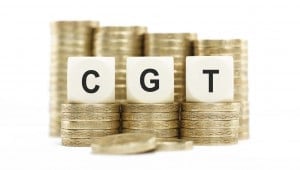Capital gains tax (CGT) is the tax you pay on profits from selling assets, such as property.
In essence, you make a capital gain when the difference between what it cost you to acquire your property and what you gained from selling it is greater than zero — otherwise, you make a loss.
You report capital gains and capital losses in your income tax return and pay tax on your capital gains.
Although it is referred to as ‘capital gains tax,’ it’s actually part of your income tax – not a separate tax.
This tax does not apply to your own home, known as your principal place of residence.
So, in this article we’ll outline what CGT is, how to legally minimise it, and how to calculate it, so no one’s surprised when the taxman (or woman) comes a-calling.
What is Capital Gains Tax?
Capital Gains Tax or CGT is one of those taxes no one really wants to pay.
CGT was introduced in Australia in 1985 and applies to any asset you’ve acquired since that time unless specifically exempted.
If you ask me, CGT is the last throw of the dice the tax department has to reduce your family’s wealth.
That’s because the more capital gains you have made, due to either a good investment or through a long-term holding, the more tax that will be applied if you sell your asset.
Annoyingly, even after your death, your beneficiaries will be taxed on investments you have made that they subsequently sell.
You see, the Australian Taxation Office is very patient and will wait many years or even decades for its last throw of the dice!
In fact, this tax may even be applied in certain circumstances without an asset sale, such as leaving your children an inheritance on your death either as a superannuation payment (not exactly CGT but a tax nevertheless) or if they are living overseas at the time of your death depending on the assets.
But in general, as I mentioned, a capital gain or capital loss on an asset is the difference between what it cost you and what you receive when you dispose of it.
You pay tax on your capital gains but not a separate tax by itself.
Instead, the capital gain you make is added to your assessable income in whatever year you sold the property.
Even though it forms part of your income tax and is not considered a separate tax – it is still referred to as CGT (Capital Gains Tax.)
But if an asset is held for at least one year, then any gain is first discounted by 50 per cent for individual taxpayers or by 33.3 per cent for superannuation funds.
The date you sell or dispose of an asset (the ‘CGT event’)
If there is a contract of sale, the CGT event happens when you enter into the contract.
For example, if you sell a house, the CGT event happens on the date of the contract, not when you settle.
If there is no contract of sale, the CGT event is usually when you stop being the asset’s owner.
For example, if you sell shares, the CGT event happens on the date of sale.
Capital losses can be offset against capital gains, and net capital losses in a tax year may be carried forward indefinitely.
However, capital losses cannot be offset against normal income.
According to the ATO, most personal assets are exempt from CGT, including your home, car, and most personal use assets such as furniture. CGT also doesn’t apply to depreciate assets used solely for taxable purposes, such as business equipment or fittings in a rental property.
If you’re an Australian resident, CGT applies to your assets anywhere in the world.
Foreign residents and capital gains tax
If you are a foreign resident or a temporary resident, you:
- pay capital gains tax (CGT) only on your taxable Australian property
- cannot claim some CGT discounts and exemptions.
Foreign residents are subject to foreign resident capital gains withholding on the sale of Australian real estate worth more than $750,000.
How your residency affects CGT:
- Foreign and temporary residents are subject to CGT only on taxable Australian property, such as real estate in Australia and assets used to carry on a business in Australia.
- The 50% CGT discount is generally not available to foreign and temporary residents for assets acquired after 8 May 2012.
- Foreign residents are not entitled to the main residence exemption unless they satisfy the requirements of the life events test.
- If you become an Australian resident, or stop being one, the assets on which you pay CGT in Australia will change.
Assets you acquired before CGT started on 20 September 1985 are not subject to CGT.
How much is Capital Gains Tax?
When it comes to calculating how much CGT you have to pay, other than in superannuation, there is no specific rate of tax that is applied, rather the applicable gains are added to a taxpayer’s income and the tax rate is applied to their total income, which includes the capital gain or loss
The final tax rate will depend on your personal marginal tax rate.
CGT can be a little tricky to calculate, that’s why it’s so important to have specialists on your side – and especially a good taxation accountant.
Remember CGT is only payable in the financial year in which you sell or dispose of your rental property.
So, if you follow a long-term wealth creation strategy you won’t need to worry about paying this for many years or possibly decades. 
In the meantime, you can access any capital growth to grow your portfolio and improve your overall financial position.
For most CGT events, your capital gain is the difference between your capital proceeds and the cost base of your CGT asset – that is, where you receive more for an asset than it cost you.
According to the ATO, the cost base of a CGT asset is largely what you paid for it, together with some other costs associated with acquiring, holding and disposing of it.
If the rental property or asset was acquired before 1985, then no CGT is payable, however, major improvements to a property since that time may be subject to CGT.
There are three options to calculate your capital gain
You can choose the method that gives you the best result (that is, the smallest capital gain) as long as you satisfy certain conditions.
The three different calculations are:
CGT discount method
For assets held for 12 months or more before the relevant CGT event. Allows you to reduce your capital gain by:
- 50 per cent for individuals (including partners in partnerships) and trusts
- 3 per cent for complying super funds.
This is generally not available to companies.
Indexation method
For assets acquired before 11.45 am (by legal time in the ACT) on 21 September 1999 (and held for 12 months or more before the relevant CGT event).
- Allows you to increase the cost base by applying an indexation factor based on the consumer price index (CPI) up to September 1999.
Another method
For assets held for less than 12 months before the relevant CGT event. To determine whether you acquired the asset at least 12 months before the CGT event, exclude both the day of acquisition and the day of the CGT event.
- The basic method of subtracting the cost base from the capital proceeds.
An example of using the CGT discount method is: 
Julie buys a rental property on 1 June 2014 for $300,000 and sells it for $350,000 on 15 July 2015.
As she owned the asset for more than 12 months she is entitled to the 50 per cent CGT discount.
She would need to also subtract the cost base from the capital proceeds, deduct any capital losses, then reduce by the relevant discount percentage.
There are a number of Capital Gains Tax calculators available online so you can work out how much CGT you might have to pay if you sell a rental property.
It’s important, of course, to use a specialist taxation accountant when it comes to time to lodge your tax return for the financial year in which you’ve disposed of the asset.
Avoiding Capital Gains Tax by living in the property
When it comes to property, one of the major exemptions from Capital Gain Tax is if it’s your home or principal place of residence (PPOR).
You can generally claim the main residence exemption from CGT for your home.
To get the exemption, the property must have a dwelling on it and you must have lived in it.
You’re not entitled to the exemption for a vacant block.
Generally, a dwelling is considered to be your main residence if:
- You and your family live in it.
- Your personal belongings are in it.
- It is the address your mail is delivered to.
- It is your address on the electoral roll, and
- Services such as phones, gas, and power are connected.
There is also a tax break that you may be able to access if your PPOR becomes a rental property.
There is a special six-year rule, which means that a property that was previously your PPOR can continue to be exempt from CGT if sold within six years of first being rented out.
The exemption is only available where no other property is nominated as your main residence.
What’s interesting about this rule is that if the same dwelling is reoccupied as your main residence, then the six-year exemption resets.
So another six years of exemption is available from the date it next becomes income-producing.
Paying Capital Gains Tax if your main residence is used for business
Advancements in technology mean that more and more people are working either from home or working for themselves.
A tax issue that many people find themselves in, however, is that if they work from home or use the home for business purposes, that may trigger some form of CGT.
It’s important to understand that if your employer has an office in the city or town where you live, your home office will not be a place of business, even if your work requires you to work outside normal business hours.
Also if your income includes personal services income, you may not be able to claim a deduction for occupancy expenses.
According to the ATO, it’s important to consider any CGT impacts of claiming your home as a business premise.
To work out the capital gain that is not exempt, you need to take into account a number of factors including:
- The proportion of the floor area of your home is set aside to produce income.
- The period you use it for this purpose.
- Whether you’re eligible for the “absence” or six-year rule
- Whether it was first used to produce income after 20 August 1996.
How will the capital gains tax be calculated on a home that becomes an investment property?
If you’re wondering how capital gains tax will be calculated on a home that becomes a rental property watch this short video that answers Hamish’s question which is quite common for many people. their first home isn’t their final home and turns into an investment.
I also explain how whether you put a tenant into your home before you live there or the other way around makes a big difference as well as the 6-year rule for exemption of your home from Capital Gains Tax.
In summary, you can retain your main residence exemption for up to six years once you move out unless, of course, you’ve identified another property as your main residence.
You can only have one residence for tax exemption at a time.
The beauty of it is you don’t have to identify which residence until you sell one.
Then you do the numbers and you work out which property gives you the best tax advantage.
In this regard, the ATO is pretty good.
To calculate the tax, what we need to do is go back and determine the market value of the property at the time you moved out.
That sets up the cost base to determine the profit on the sale.
You get the selling price less any costs, of course, and you compare it back to the market value on the date you moved out and rented the property.
That creates the profit that we then look at to see how much is taxable.
The way we calculate what’s taxable is we look at the number of days you’ve owned it in total and you compare that to the number of days you had a tenant in there while taking into account up to six years, you can have it as tax-free.
So it’s a proportion of the number of days you had a tenant versus the number of days you owned it, but you only multiply that against the profit based on the market value at the time you sold.
Avoiding Capital Gains Tax with a Self-Managed Super Fund
The ability to borrow money to invest in property, in particular, by using the mechanism of an SMSF has resulted in the number of funds increase rapidly in recent years.
Close to 600,000 SMSFs are now in operation, according to the latest statistics released by the Australian Taxation Office (for December 2015).
While people have generally always been able to buy a property through SMSFs, what has changed in the past few years is that SMSFs can now borrow money to do so.
Buying a property through an SMSF should not be the sole reason that someone chooses to set up an SMSF but it can be an option for people who want more control over their super.
Similarly, it’s important to not consider buying the property with an SMSF solely as a way to avoid or minimise, paying CGT.
It should work for your long-term investment strategy as well as meet a number of checks and balances for your financial future.
If you do choose to invest in property using an SMSF, the unique ownership structure provides a number of taxation benefits.
If you sell the property once you’ve retired, you’ll pay no capital gains on the property.
There’s also a 33 per cent discount available under the CGT discount method calculation.
Borrowing or gearing your super into the property must be done under very strict borrowing conditions and can present investment risks.
Some of the property risks associated with geared real estate bought via a SMSF include:
- Higher costs – SMSF property loans can be more costly than other property loans, which must be factored into your investment decision.

- Cash flow– Loan repayments must be made from your SMSF, which means your fund must always have sufficient liquidity or cash flow to meet the loan repayments.
- Hard to cancel– If your SMSF property loan documentation and contract is not set up correctly unwinding the arrangement may not be allowed and you may be required to sell the property, potentially causing substantial losses to the SMSF.
- Possible tax losses– Any tax losses from the property cannot be offset against your taxable income outside the fund.
- No alterations to the property– Until the SMSF property loan is paid off alterations to a property cannot be made if they change the character of the property.
You may also want to read:
- What Capital Gains Tax is and what it isn’t
- How will the capital gains tax be calculated on a home that becomes an investment property?
from Property UpdateProperty Update https://propertyupdate.com.au/a-complete-guide-to-capital-gains-tax/
No comments:
Post a Comment